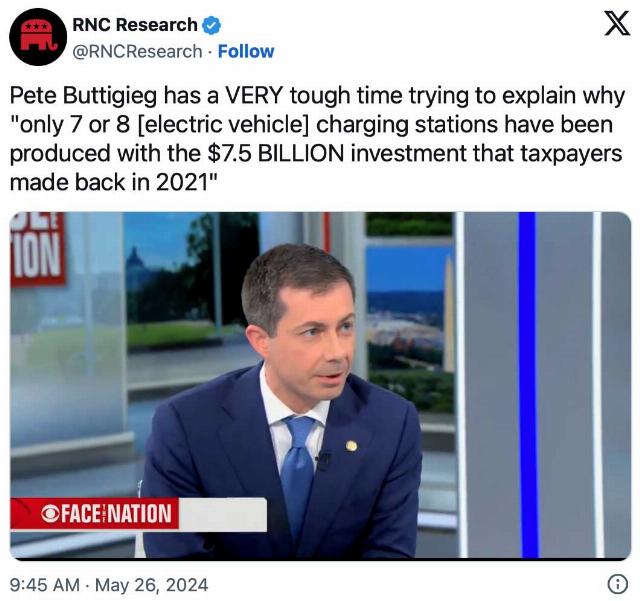Is an electric vehicle collapse inevitable?
Were one to listen to Transportation Secretary Pete Buttigieg, or Energy Secretary Jennifer Granholm, one might come away with the impression that electric vehicles (EVs) are so popular, the government’s intention of mostly replacing internal combustion engine (ICE) vehicles with EVs by 2030 was a foregone conclusion. After all, the Mummified Meat Puppet Administration (MMPA) tells us they’ll build a half million fast chargers across America by then to handle the load, and they’ve allocated $7.5 billion we don’t have to that noble endeavor.

Graphic: X Screenshot
Confronting Secretary Pete with the fact that in two years his bureaucracy has managed to build only seven or so—one billion plus per charger!—produces much sputtering and stammering and no answers. As the meme goes, he’s so bad at his job, Americans actually know who the Transportation Secretary is, but more on that later.
Hertz unloading its EV fleet has been much in the news. Americans have a nasty tendency not to buy, or even rent, vehicles they don’t trust and don’t want. And now, even General Motors is beginning to bow to reality:
General Motors is trimming its expected sales and production of all-electric vehicles this year, as U.S. adoption of EVs occurs slower than expected.
GM Chief Financial Officer Paul Jacobson said the company now expects production of its all-electric vehicles to range from 200,000 to 250,000 this year, down from a previously announced range of 200,000 to 300,000. The company has recently said it will produce volume to match demand, which is growing more slowly than had been forecast.
Jacobson thinks EVs make up about 8% of the market, which is less than EV cheerleaders have been claiming, and about the historic average. Don’t trust those numbers. Trust demand:
“We are very focused on the profitability of our [internal combustion engine] business, we’re growing and improving the profitability of our EV business and deploying our capital efficiently. This allows us to continue returning cash to shareholders,” Jacobson said in a release.
Translation: EVs are huge money losers, so we’re trying not to make all the money we’re losing on them too obvious to GM shareholders who might get kind of angry about losing dividends.
Maybe it would be better if GM didn’t have so many annoying stockholders demanding they actually sell vehicles that make a profit?
General Motors on Tuesday said its board approved a fresh repurchase authorization to buy back up to $6 billion worth of the automaker's common stock, a month after beating Wall Street estimates in the first quarter on strong demand for gas-powered vehicles. [skip]
GM previously announced a $10 billion share buyback in November, and on Tuesday said that roughly $1.4 billion in capacity remains under that agreement. In the first quarter, the company repurchased $300 million shares, and plans to buy back the remaining $1.1 billion by the end of the second quarter.
A billion here, a billion there, pretty soon you’re talking real money. Surely GM knows the MMPA isn’t going to bail them out, particularly if Biden isn’t reelected?
And now we know at least part of the reason Secretary Pete has been so inefficient in building EV charging stations. A famous aphorism observes if the federal government were put in charge of the Sahara Desert, in no time at all there would be a sand shortage. Here’s why we have a charging station shortage:
But internal memos from the Department of Transportation obtained by the Washington Free Beacon, as well as interviews with those who are responsible for overseeing the implementation of the electric vehicle charging station project, say the delay is in large part a result of the White House’s diversity, equity, and inclusion initiatives.
"These requirements are screwing everything up," said one senior Department of Transportation staffer who spoke on the condition of anonymity. "It’s all a mess."
How is DEI—didn’t earn it—screwing things up? At least 40% of the money has to go to “underserved communities,” which is brilliant because those are the communities least able to afford, or want, an EV, so they have no use for EV chargers.
That’s the continuing EV problem. Americans know they can’t count on EVs to meet their needs, and at an average price of $60,000+ dollars, they’re $30,000 or so more expensive than most Americans can afford. Americans can, however, count on government to screw everything up, so there may be hope of the entire EV edifice collapsing before it bankrupts the entire country.
Mike McDaniel is a USAF veteran, classically trained musician, Japanese and European fencer, life-long athlete, firearm instructor, retired police officer and high school and college English teacher. He is a published author and blogger. His home blog is Stately McDaniel Manor.





